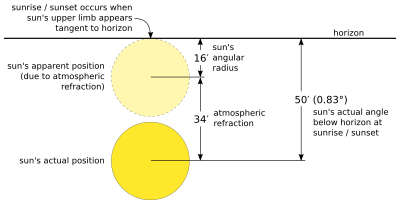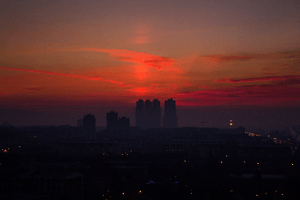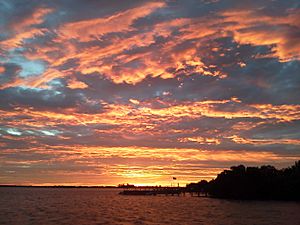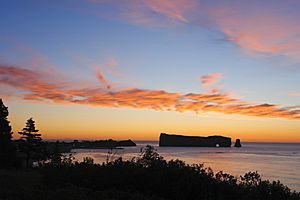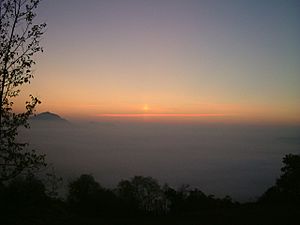Sunrise facts for kids
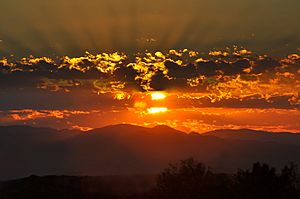
Sunrise (or Sun up) is the moment when the upper limb of the Sun appears on the horizon in the morning.
The term can also refer to the entire process of the solar disk crossing the horizon and its accompanying atmospheric effects.
Contents
Terminology
"Rise"
Although the Sun appears to "rise" from the horizon, it is actually the Earth's motion that causes the Sun to appear.
Beginning and end
Astronomically, sunrise occurs for only an instant: the moment at which the upper limb of the Sun appears tangent to the horizon. However, the term sunrise commonly refers to periods of time both before and after this point:
- Twilight, the period in the morning during which the sky is brightening, but the Sun is not yet visible. The beginning of morning twilight is called astronomical dawn.
- The period after the Sun rises during which striking colors and atmospheric effects are still seen.
Measurement
Angle
Sunrise actually occurs before the Sun truly reaches the horizon because Earth's atmosphere refracts the Sun's image. At the horizon, the average amount of refraction is 34 arcminutes, though this amount varies based on atmospheric conditions.
Also, unlike most other solar measurements, sunrise occurs when the Sun's upper limb, rather than its center, appears to cross the horizon.
Time of day
The timing of sunrise varies throughout the year and is also affected by the viewer's longitude and latitude, altitude, and time zone. These changes are driven by the axial tilt of Earth, daily rotation of the Earth, the planet's movement in its annual elliptical orbit around the Sun, and the Earth and Moon's paired revolutions around each other. The analemma can be used to make approximate predictions of the time of sunrise.
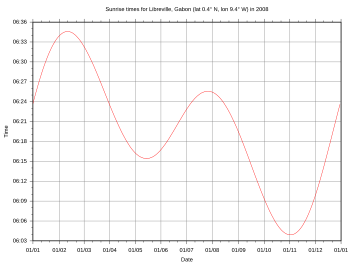
In late winter and spring, sunrise as seen from temperate latitudes occurs earlier each day, reaching its earliest time near the summer solstice; although the exact date varies by latitude. After this point, the time of sunrise gets later each day, reaching its latest sometime around the winter solstice.
Appearance
Colors
Air molecules and airborne particles scatter white sunlight as it passes through the Earth's atmosphere. This is done by a combination of Rayleigh scattering and Mie scattering.
As a ray of white sunlight travels through the atmosphere to an observer, some of the colors are scattered out of the beam by air molecules and airborne particles, changing the final color of the beam the viewer sees. Because the shorter wavelength components, such as blue and green, scatter more strongly, these colors are preferentially removed from the beam.
At sunrise and sunset, when the path through the atmosphere is longer, the blue and green components are removed almost completely leaving the longer wavelength orange and red hues seen at those times. The remaining reddened sunlight can then be scattered by cloud droplets and other relatively large particles to light up the horizon red and orange. The removal of the shorter wavelengths of light is due to Rayleigh scattering by air molecules and particles much smaller than the wavelength of visible light (less than 50 nm in diameter). The scattering by cloud droplets and other particles with diameters comparable to or larger than the sunlight's wavelengths (more than 600 nm) is due to Mie scattering and is not strongly wavelength-dependent. Mie scattering is responsible for the light scattered by clouds, and also for the daytime halo of white light around the Sun (forward scattering of white light).
Sunset colors are typically more brilliant than sunrise colors, because the evening air contains more particles than morning air.
Ash from volcanic eruptions, trapped within the troposphere, tends to mute sunset and sunrise colors, while volcanic ejecta that is instead lofted into the stratosphere (as thin clouds of tiny sulfuric acid droplets), can yield beautiful post-sunset colors called afterglows and pre-sunrise glows. A number of eruptions, including those of Mount Pinatubo in 1991 and Krakatoa in 1883, have produced sufficiently high stratospheric sulfuric acid clouds to yield remarkable sunset afterglows (and pre-sunrise glows) around the world. The high altitude clouds serve to reflect strongly reddened sunlight still striking the stratosphere after sunset, down to the surface.
Optical illusions and other phenomena
- Atmospheric refraction causes the Sun to be seen while it is still below the horizon.
- Light from the lower edge of the Sun's disk is refracted more than light from the upper edge. This reduces the apparent height of the Sun when it appears just above the horizon. The width is not affected, so the Sun appears wider than it is high.
- The Sun appears larger at sunrise than it does while higher in the sky, in a manner similar to the Moon illusion.
- The Sun appears to rise above the horizon and circle the Earth, but it is actually the Earth that is rotating, with the Sun remaining fixed. This effect results from the fact that an observer on Earth is in a rotating reference frame.
- Occasionally a false sunrise occurs, demonstrating a very particular kind of Parhelion belonging to the optical phenomenon family of halos.
- Sometimes just before sunrise or after sunset a green flash can be seen. This is an optical phenomenon in which a green spot is visible above the Sun, usually for no more than a second or two.
See also
 In Spanish: Orto para niños
In Spanish: Orto para niños



